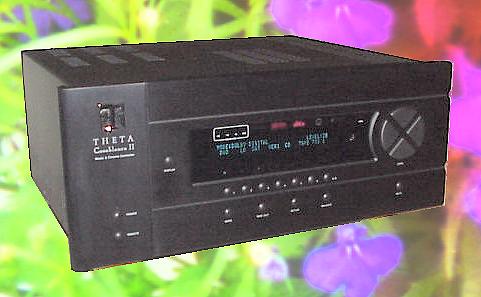Product Review -
Theta Casablanca II with Fully Balanced 24/384 DACs - October, 2001
John E. Johnson, Jr.
![]()
|
|
Specifications: Twelve Channels, Fully Balanced DACs, 24 bit - 384 kHz MFR: 20 Hz - 48 kHz 24 Bit DSP with 56 Bit Accumulator Inputs: Coaxial RCA, Toslink, AC-3 RF, XLR, 10 kOhm Impedance, RS232 Input for Software Updates Outputs: XLR Size: 7 1/2" H x 19" W x 16" D Weight: 43 Pounds MSRP: $18,530 USA as Configured
|
|
Theta Digital, 5330 Derry Avenue, Suite R, Agoura Hills, California 91301; Phone 818-597-9195; Fax 818-597-1079; E-Mail [email protected]; Web http://www.thetadigital.com |
Introduction
There are so many wonderful things about the Casablanca II, it is difficult to write an introduction. And, this is certainly not the first review of the product, as it has been around for a couple of years. However, it is the first review of the Casablanca II with their new 24 bit - 384 kHz fully balanced DACs, and that brings up one of the most important characteristics of the Theta: It is totally upgradeable.
I was fortunate enough to obtain the model II with their Standard and Superior DACs at first. I had Standard DACs for the rear channels (18 bit Delta Sigma - 48 kHz), and Superior DACs in the front (20 bit - 96 kHz). Everything sounded great, but there wasn't really anything that I would be able to say about it in this review that had not been said before. Then, I heard that Theta had just released what they call their Xtreme DACs. They are fully balanced, 24 bit - 384 kHz cards. This means they will accept all digital formats that are available today, including 24/192 signals. Of course, digital outputs from DVD-A and SACD are not ready yet, but when the consortium finally releases them, the Theta Casablanca II will be able to decode them. Theta does not have a 5.1 analog input card because they feel that the Casablanca would be compromised by the less than adequate DACs in players that output 5.1 analog audio. They will supply an outboard box for those who want to use 5.1 analog outputs from these players though.
Why did Theta have, as their Superior DAC, only 20 bit - 96 kHz capability, when 24/96 and even 24/192 DACs are commonly available in other products, including mass market receivers? Well, Theta found that the best sound was obtained with the then available DAC chips when they were limited to 20 bits. Also, it should be noted that there is a wide range of quality in DAC chips, and therefore, just because a chip is rated at 24/96 does not mean it will sound better than any 16/44.1 chip. This all changed in the last year, when the latest generation of chips were released, and the Xtreme DAC card was born. Because it is leading edge, and because only the best associated parts can be used on the card in order to get the best performance out of the chip, the Xtreme DAC card is very expensive. Each card is $4,000. If you have all channels with the 24/384 DACs, this adds $12,000 to the base price. So, we are in the Ferrari and Mercedes class of hi-fi processors. Is it worth the cost? Let's see.
Installation of Upgrades
Although upgrading the DAC cards and the necessary software is normally done only by dealers, Secrets has as its readership many aficionados who are computer savvy, and who routinely make hardware and software upgrades to their computers. So, I want to go over how I performed the upgrades, especially since upgradeability is one of the most important features of the Casablanca.
First, here is a photo (below) of the original DAC. You can see the connectors at the bottom (horizontal tan colored jacks). The right side edge has XLR and RCA output jacks.

Now, here is a photo of the Xtreme DAC (below). On the right side edge, there are no RCA output jacks as there are on the Superior DAC. That is because there is no room for them. This is a fully balanced DAC that is totally designed to be used as such. So, you will need a power amplifier that has XLR input jacks. You will also need balanced XLR cables. You could use adapters if you wish, but that throws out some of what you are paying for. Balanced amplifiers will help give you the fine detail that 20 bit - 24 bit music will contain, because they are so quiet.
In my case, I tested the Casablanca II with several power amplifiers, including the Theta Dreadnaught, Cinepro 2k6 SE Gold, and Rotel RMB-1095. All of these amps have balanced inputs, and the Dreadnaught as well as the Cinepro are full balanced circuits. I used Nordost Silver Shadow balanced cables for the main and surround channels, and BetterCables Silver Serpent balanced cables for the subwoofer channels as well as the side channels. I particularly like the Silver Serpents for situations where flexibility is important, and with my subs as well as the power amplifier for the side channels, I needed something that could easily bend around enclosures. The Silver Serpent XLRs were perfect for this. The Nordost Silver Shadow are extremely high tech, so they were assigned to the main channels, but they are stiff. I put up with that because they are so good.

Comparing the two boards, you might wonder why there is so much difference in price, when the basic layout of the boards looks similar. Well, besides the Burr-Brown chips, of which there are eight on the board - two per balanced channel (they are about $40 apiece), the DAC boards are Teflon where the copper traces are, instead of glass, and this is a real pain in the tush to manufacture since nothing sticks to it. In other words, how do you get copper traces to adhere to the Teflon boards? I guess the answer to that one is proprietary, and I had enough difficulty just getting them to tell me it was Teflon. The advantage of Teflon is its low dielectric constant, which lowers capacitance.
I removed screws from the chassis cover, and there were a ton of them. After removing the cover, I found I had to undo a bunch more screws which attached metal cross braces inside. The braces not only make the chassis strong, but they hold the cards vertical and also hold vertical shielding plates between the cards.
Once the braces were removed, I pulled the original cards out and inserted the three new 24/384 cards in their place. After having changed so many cards in my PC, this was a piece of cake. It was like putting in a new sound card, video card, or SCSI card, but these DAC cards are much larger and heavier.
Screws hold the cards at the rear of the chassis, and the braces have notches to hold them in place vertically, so I had to make sure the braces were in place before I replaced the screws at the rear of the cards.
The Software Update
Before the new DAC cards were installed, I had to update the software. Theta supplied a CD ROM with the computer software application program, along with a floppy that had the latest OS for the Casablanca. So, I installed the application, using Win ME, and followed the instructions. Here is another great thing. Theta had supplied me with instructions written specifically for my unit. They told me exactly what to do for my cards. This is important because the Theta is so flexible, there are dozens and dozens of configurations. Each requires a specific set of instructions.
Here is what the PC application interface looks like (see photo below).
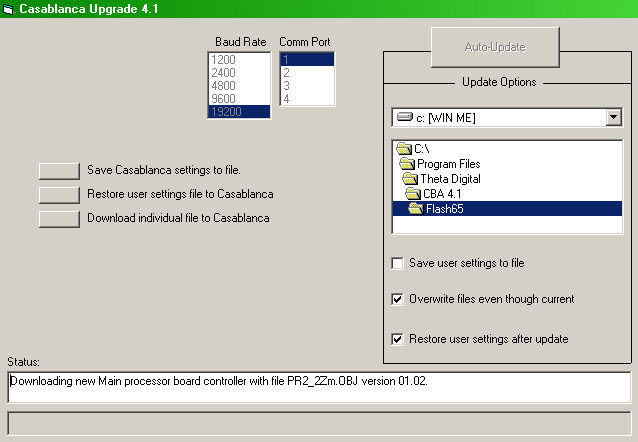
Note the Flash65 folder under the CBA 4.1 folder. CBA 4.1 is the latest version of the application that runs on your PC, and Flash65 is the update that gets transferred to the Casablanca through the RS232 port. So, all I had to do was connect a DB9 serial port cable (don't use a null version of the cable) on a serial port of the PC and the RS232 port on the Casablanca, and click the Auto-Update button on the program (top right corner of the screen). The status bar (bottom of screen) said it was communicating and then downloading. At the end, I saw this screen (photo below). The update was complete.

I disconnected the cable, turned off the power, and installed the new DAC cards as described above. After turning the Casablanca back on, I then followed the written instructions that Theta had sent me for configuring my unit to have seven channels of main sound and five channels for subwoofers (total of twelve channels). This is usually done by the dealer, but I did it myself, and it went without a hitch.
Setup
The menu items are selected by pressing the "Set-Up" button on the front panel, and then buttons 1 - 6 and A - D, also on the front panel. Here is a table of screen shots, showing the various menus:
 1 |
 2 |
 3 |
 4 |
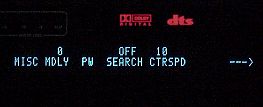 5 |
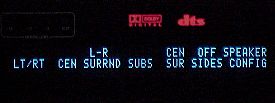 6 |
 7 |
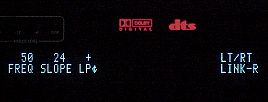 8 |
 9 |
 10 |
 11 |
 12 |
 13 |
 14 |
 15 |
 16 |
 17 |
 18 |
 19 |
 20 |
|
The remote control allows access to the various features even though it has a very simple layout (photo below). I like this simplicity, and my only gripe is the same one I have for other remotes: It does not have buttons for direct control of volume for all channels without going into the second layer menu pages. The four level control buttons on the remote are only for controlling the main volume rather than individual channels. In any case though, it is an easy to use remote.

The main on/off power toggle is on the rear, but it remains in standby until you press the power button on the front panel. So, the unit is already warmed up when you are ready to watch a movie. There are no knobs. Just push buttons, including the level controls on the right hand side of the front panel. At power on, the unit goes through a sequential check for installed boards, and after a few seconds, it is ready for use.
The Casablanca will automatically search for input signals, so I connected a Toslink cable from the Toshiba DVD player, turned it on, and the Theta set things up with input 1 being for the DVD player (menu photo 1 above). Dolby Digital was default for this input, and when I put in a DTS DVD, input 1 automatically switched to processing DTS signals. Any input jack can be configured to go to any input you want (DVD, VCR, Satellite, CD, etc.), so it is incredibly flexible to customize.
You can adjust the panel brightness if you like, even turning it off completely, but I enjoy having blue LEDs off to the side of the movie screen. It gives me room reference.
Pressing the Set-Up button takes you to menu 2, and then you press the number buttons (1-6) underneath the items you want to change. In this case, I selected Input (menu 2) and then Config (menu 3), which let me configure my speaker settings. I selected Input 1 which gave me menu 6. From there, I configured each speaker with a high-pass crossover type (Linkwitz-Riley) and frequency such as shown in menus 7 and 8. You can select the slope up to 24 dB per octave, and crossover frequency from 40 Hz to 160 Hz in various increments depending on the different crossover types. It lets you select different crossover types (Linkwitz-Riley, Phase Perfect, and Butterworth) as well as slope and frequency for each speaker. Bass management in most other processors only lets you pick one type for all the speakers at any one time. The Casablanca has, like all processors, an On-Screen Display if you like to use them, but I preferred working directly from the buttons on the front panel and reading the display there.
You can change the jack names (menu 13) and customize the messages that are displayed (menu 14). Macros can be copied between inputs (menu 15) if you like, so that you only have to program them once. The menus can be password protected (menu 14) if you think someone (the kids) might fiddle with your customization, but you need to be careful to write the password down because if you lose it, you won't be able to access the menus for changes without uploading the OS from your computer again (like reinstalling Win 98).
Although all the speakers in my reference system are full range, I found that the power of the amplifiers I was using caused the panels in the ESLs to be overdriven by low frequencies. So, I high-passed them at 50 Hz and this eliminated the problem. Then I decided to high-pass all the speakers at this frequency (50 Hz) and let the subs handle everything below 50 Hz. It worked extremely well.
I tried several types of crossovers for the subwoofers and ended up by running them at "Full" which means no crossover. This gave me the sound I preferred, with adjustments of the crossover being done with the knob on the back of the subwoofers themselves, rather than in the Theta.
Speaker delay settings are in ms up to 31 milliseconds, depending on whether you are setting delays for the side speakers or the rear surrounds. Because we sit in various parts of the room, for demo and testing, I like to use 0 delay. With the Casablanca, you can't set the rear surround or side surround speakers less than 15 ms. The 15 ms delay for the rear is required for Pro Logic and is part of the license requirements from Dolby, but Dolby Digital and DTS don't require the 15 ms. Calculating delay is based on the difference between the distance from the front speakers to your listening position and the distance from the rear speakers to your listening position. For every foot closer that your rear speakers are, you add 1 ms of delay to the rear. So, if your front speakers are 10 feet from your couch, and your rear speakers are 5 feet from your couch, you would add 5 ms of delay to the rear channels. In Pro Logic, you would have a total of 20 ms delay in the rear (15 ms to start with, and 5 ms extra for the distance), but for DD and DTS, it should be 5 ms total. Right now, you can't set it that way with the Casablanca II, in a direct way. This is something that needs to be modified in future software upgrades so that all channels are variable from 0 ms up. For our situation, I left the rears at 15 ms, and added 10 ms delay to the front left/right and center (menus 16 and 17). This left a net delay of 5 ms in the rear, which worked fine, but this is an indirect procedure. To bring the total net delay for all the channels to 0, I had to go to DD (menu 18), and then the second page of the menu (menu 19) to reduce the surround delay from - 15 ms (menu 19) to - 20 ms (menu 20). This procedure is very cumbersome.
OK, now to add to the confusion, forget the last few sentences of the last paragraph. I am leaving them in for now, just so you can see how confused I got with the speaker setting menu. Here is the final info I got from Theta. They designed the Casablanca and Casanova to be set up by dealers and installers, not the end users. Since they give training sessions to dealers and installers, it was not important that it be intuitive. The default setup is 15 ms delay to the rear surround speakers in the Speaker Config menu. In the Dolby Digital menu, the default is - 15 ms, which means that it subtracts 15 ms from the Speaker Config, and thus resets everything to a net of 0 delay in all channels. Same thing for the DTS menu.
The way this thing should be set up is a menu where you just punch in the distance from each speaker, including subwoofers, to your sitting position, and the processor calculates the delays for each mode. You could fine tune it from there if you like. The distances should be in 0.5 foot increments. To heck with all this adding ms in one menu and then subtracting it from another menu nonsense. I'm too old for that. It takes me 10 minutes just to count out $1.50 from the coins in my hand for my daily Coke at Burger King.
An internal pink noise generator is used to set relative volume in each channel.
The three 24/384 DACs were configured as follows: DAC-1 for Front-Left, Front-Right, Front-Center, and Sub-1 (menu photo 10), DAC-2 for Sub-2, Sub-3, Sub-4, and Surround-Center (menu 11), DAC-3 for Left-Surround, Right-Surround, Center-Surround, Side-Left, and Side-Right (menu 12). Although I had DACs for 4 subwoofers, I set it up with three, which gave me front stereo subwoofers and a sub for the rear signal as well. The possibilities are One Sub = Front, Two Subs = Either Front/Rear or Stereo Front Left/Right, Three Subs = Stereo Front Left/Right and One in the Rear, Four Subs = One in Each Corner, and Five Subs = One in Each Corner and Center Sub. So, you have to go to five subs to have a front center subwoofer. I would prefer the first three to be front left/right (stereo subs) and center channel sub. Perhaps that could be a software upgrade option in the future.
Insofar as the DAC chips themselves are concerned, they are Burr-Brown 1704s, which are listed as 24/96 at 8X oversampling. Theta upsamples all the digital audio data to 24/384 (incoming analog data are converted to digital with A/D converters), which would leave room for 2X oversampling, but 384 is as far as Theta carries it.
Performance
To test the Casablanca II, I used a Toshiba SD-6200 DVD player, with progressive component video (BetterCables Silver Serpent cables) to a Sony 10HT front projector, and Toslink cable to the Casablanca digital audio Toslink input jack. Balanced audio outputs from the Casablanca went to the power amplifiers (Theta Dreadnaught [review of this amplifier coming soon], Cinepro 2k6 SE Gold, and Rotel RMB-1095). Speakers were Krix Centrix for the Center, Krix Esoterix for the rear, and full range Threshold ES-500 ESLs for the front left/right. Speaker cables were Nordost.
With the Sony 10HT projector and a large screen, part of my front speakers are behind the screen. Secondly, the ESLs are much, much different than the Krix center channel speaker. This is on purpose, as I want to see what a processor is capable of doing in real world problem situations. So, I activated the center channel spread feature of the Casablanca (menu 5, Ctrspd). This blends part of the center channel to the front left/right speakers. I set it to 10, which means 2/3 of the center goes to the left/right speakers. It made a huge difference and improved the entire presentation. I found I had to turn the center volume up quite a bit to make up the difference in the sensitivity of the center speaker (cone) vs. the ESLs (electrostatic) though, and the volume of individual channels is accessed in menus 3 (Lvls) and then menu 9 for the levels with input 1 (DVD).
As I mentioned, I had the fortuitous opportunity to compare the Standard and Superior DACs with the Xtreme DACs. Although I was happy with the original DACs, I was not prepared for the difference that the Xtreme DACs would make. There was less noise due to every DAC being fully balanced. Bass was even tighter than before, and it was tight to begin with (no mass market receiver I have tested has this kind of bass tightness). The midrange and treble (detail) improvement were very obvious. There is no subtlety to what you get when you spend this kind of money for such a high performance DAC.
Movie after movie, music disc after disc, the sound was just breathtaking. DD and DTS sound tracks are shown off to their ultimate capabilities with a processor like this. The sound stage snapped into focus. No harshness, grittiness, or over-sibilance. Voices sound human, not digital. Keep in mind this is not just a characteristic of good DAC chips, but all of the supporting circuitry and parts quality as well.
In "Along Came a Spider", I had to check to see if it was raining outside on my deck, but no, it was the rear surround channels.
One of my favorite films, "True Lies", left some visitors to our lab with jaws agape. It is a very satisfying feeling when guests applaud after a demo of one's system.
Chapter 29 of "The Matrix" is everyone's demo. The automatic pistols and rifles are going off in every channel, and it is extremely demanding of processors, amplifiers, and speakers. No weakness here.
For CDs, you have to select the type of processing you want. For example, just plain vanilla stereo, or Pro Logic, or Theta's version of Matrix. There are none of the mass market DSP modes like Hall, Stadium, etc. DPL-II, THX-EX, and DTS-ES are not available yet on the Casablanca II, but they will be soon, using a software upgrade and perhaps a chip exchange. In any case, the CD digital decoding engine (using the Toslink connection from our transport) is as good as I have ever heard.
All of the power amplifiers worked superbly with the Casablanca, and I found I could tolerate higher SPL due to the clean signal being sent to them from the processor. The Cinepro 2k6 SE Gold just rocked. Of course, the Theta Dreadnaught fit the Casblanca like a glove with its looks and performance (review coming). The Rotel, although only quasi-balanced (balanced inputs but not fully balanced circuits), gave a solid showing. The McIntosh MC-602, with its 600 watts per channel, got into the arena to drive the front left/right ESLs. High-passing them at 50 Hz let the Mc deliver full impact without slapping the panels against the stators.
Conclusions
There are no ifs, ands, or buts here. The Theta Casablanca II is a world class processor. Although it is very expensive when fully loaded, you can get the basic system at a reasonable cost and add to it over time. It is totally upgradeable and therefore never out of date. It is definitely a reference product by which just about everything else can be compared. It's beautiful and built like a tank. It sings like an angel. There can be no higher recommendation.
- John E. Johnson, Jr. -
![]()
© Copyright 2001 Secrets of Home Theater & High Fidelity
Return to Table of Contents for this Issue.

